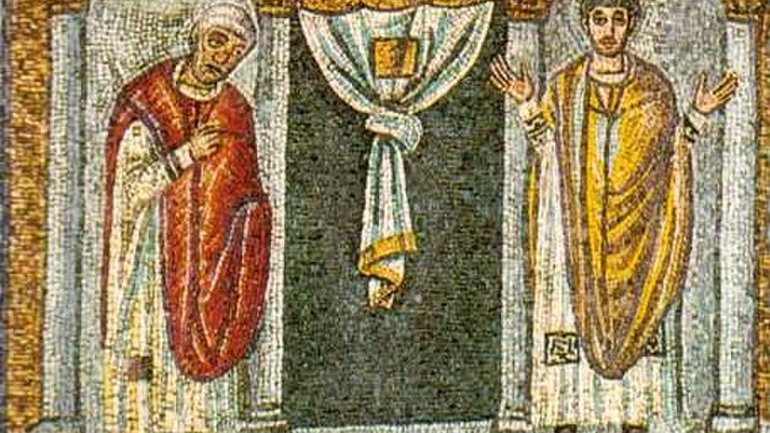
Halytski liturhijnosti

by Rev. Vasyl Rudeyko
This happens every year. Every year we begin the Paschal fast with the so-called “pre-Lenten” Sundays. In this category there are the Sunday of the Publican and the Pharisee, the Sunday of the Prodigal Sun, and Meatfare and Cheesefare Sundays. If the last two don’t raise any questions (their essence is quite clear: a gradual introduction to the fasting season, first abstinence from the consumption of meat, and then from dairy products, so that having gone away from the rich and festal, we can focus on the regular and simple for the sake of suffering with Christ in His humiliation, in His condescension from the splendor of divinity to the poverty of humanity not accepted by its own), then the first two raise certain questions, especially for the thoughtful, and for those who pray the liturgical texts of the Church and try to meditate on them.
On one hand, the liturgical texts of the “pre-Lenten” Sundays already talk about important Lenten themes: fasting, humility, following the Gospel’s teachings. On the other hand, it is forbidden to fast, since these Sundays themselves and the week between them is fast-free. On the one hand we sing “by the waters of Babylon” and “open to me the doors of repentance”, and on the other there is the encouragement to celebrate. The stichera texts and the canon of these Sundays are full of calls to weep over sins, supplications to the Lord for cleansing, and other themes which are more commonly associated with the fasting period. In addition, those who thoughtfully pray the liturgical prayer of the Church can very easily notice that the themes of these two Sundays are repeated on the third (about the Prodigal Son) and fourth (about the Publican and Pharisee) weeks of the Fast. And not only the texts of these weeks, but the texts of the proceedings Sundays are dedicated to meditating on the themes of these parables as well.
Here are some of them:
I was Thy younger son, and I wasted the wealth Thou gavest me, with drawing far from Thee into an evil life; and now I am starved and hungry for Thy blessings, O Lord who lovest mankind. To Thee I come, my Father and my God, asking forgiveness. (Troparion of the 6th Ode of the canon of the Second Sunday of the Great Fast)[1]
The Lord of all has taught us in a parable to shun the boastful thoughts of the evil Pharisees; and He has instructed all of us not to think more highly than we should. He Himself became our pattern and example, for He emptied Himself even unto death upon the Cross. Let us therefore render thanks with the Publican and say: O God who hast suffered for us and yet remained impassible, deliver us from the passions and save our souls. (Sticheron at the Praises of the Third Sunday of the Great Fast)[2] If we look closer, then we can see that other weeks of the fast are also dedicated to meditations on other parables from the Gospel of St. Luke: the parables of the merciful Samaritan (4th Sunday and 5th week) and of the rich man and Lazarus (5th Sunday and 6th week).
From already existing research (especially the wonderful work of Ivan Karabinov) it is known that the original place of the Sundays of the Publican and the Pharisee and of the Prodigal Son is the third and second Sundays of the Great Fast, corresponding to the cycle of Gospel readings in the Jerusalem tradition, which formed its liturgical piety around the meditations on selected parables from the Gospel of St. Luke.
With time, this tradition was pressured by the later monastic tradition, according to which feasts of persons or events important to the monks which fell during the Great Fast were transferred to Saturdays and Sundays. Such feasts were those of Theodore the Recruit, Gregory Palaas, Mary of Egypt, John of the Ladder, the celebration of the victory over the iconoclasts (which, by the way, was won by the monks themselves) and the veneration of the Cross of the Lord (which even in non-fasting time is venerated twice per week on Wednesday and Friday, and is regarded as the main fasting practice).
The influence of the monastic tradition was such that it partially (for it is partially present in the liturgical texts even until now) ruined the original structure of the Great Fast, and because of it two Sundays of the Fast simple fell out from among the “Sundays of the Lent” and landed between two pre-Lenten Sundays: the Sunday of Zacchaeus and Meatfare Sunday. It was these Sundays there were the original and very logical frames of the festive (fast-free) week before the beginning of the Great Fast. Zacchaeus organizes a banquet (feast) which concludes with his swearing to give to the poor and repay fourfold those whom he had wronged (meatfare), and it is this which is the main “task” for the time of the Great Fast. The faithful abstain from meat and dairy not for the sake of a diet, but in order to give to the poor that which they saved by fasting. Thus, the original logical outline of the Great Fast was this:
Fast-free week
The beginning of singing from the Triodion
Naturally, as a result of the later combining [of liturgical traditions], this original logical unity is extremely hard to see, and the themes of hymns of the “pre-Lenten Sundays” on background of the disciplinary requirement to not fast looks completely illogical. The artificial extending of the already lengthy “Forty Days”, which is also not particularly easy to count, in no way fits into the call of the II Vatican Council’s Constitution on the Sacred Liturgy to live the liturgical life: “The rites should be distinguished by a noble simplicity; they should be short, clear, and unencumbered by useless repetitions; they should be within the people's powers of comprehension, and normally should not require much explanation.”[3] It is desired that in looking at the rules and ways of fasting in the UGCC that this aspect would become important and open to the faithful their “reasonable worship” (Romans 12:1). After all, the call of the Sunday of the Publican of the Pharisee “Brethren, not pray like the Pharisee” applies to is whether our prayer is meaningful or simply the fulfillment of rules, which some day we will be able to boast before God as unquestionably and completely carried out.
Translated by Philip Gilbert